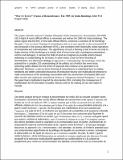| dc.description.abstract | This paper critically analyzes Canadian filmmaker Sturla Gunnarsson’s documentary Air India 182 in light of recent official efforts to remember and redress the 1985 Air India bombings. The author argues that the film, in line with official efforts, constructs a narrative of the bombings through a “war on terror” framing of remembrance that is at once specific to the recircuitries of race produced in the anxious aftermath of 9/11, and consistent with historically rooted operations of xenophobia and colonial power. The significance of such a framing is that it works not only to shape memory of the bombings as a certain kind of event (one with unambiguous perpetrators, victims and damages), it narrows the field of what are imagined as possible actions toward redressing or compensating for its losses. In other words, a war-on-terror framing of remembrance, as a discursive strategy or approach to “remembering” the bombings, limits the potential for a complex understanding of the politics out of which this event arose, restricting public debate over the kinds of responses that continue to be generated in its aftermath. Moreover, a war-on-terror framing of remembrance is understood here to employ neoliberal and settler-colonialist discourses of productive futurity and multicultural tolerance to make remembrance of the bombings concomitant with the construction of turbaned Sikhs and other racially and religiously minoritized citizens as “dangerous internal foreigners.” As such, this paper bears implications beyond the documentary film, including the consequences of neoliberalism for the formation of public memory and for the making of race and nation in Canada. / Cet article analyse de façon critique le documentaire Air India 182 du cinéaste canadien Sturla Gunnarsson à la lumière des récents efforts officiels de commémorer et de réparer l’attentat à la bombe du vol d’Air India en 1985. L’auteur soutient que le film, en accord avec les efforts officiels, élabore un récit des attentats par le biais d’un cadre de commémoration emprunté à la « guerre contre la terreur, » qui est à la fois propre aux redéfinitions de la race suscitées par l’angoisse à la suite de 9/11, et conforme aux opérations de xénophobie et de puissance coloniale historiques. L’importance d’un tel cadre est qu’il fonctionne non seulement pour façonner le souvenir des attentats comme un certain type d’évènement (dont il n’y a aucune ambigüité quant aux auteurs, victimes et indemnités), mais il restreint le champ de ce que l’on imagine comme des actions possibles visant la réparation ou la compensation pour ces pertes. Autrement dit, en empruntant le cadre de commémoration de la « guerre contre la terreur », en tant que stratégie discursive ou approche à la « remémoration » des attentats à la bombe, on limite le potentiel pour une compréhension approfondie de la politique de laquelle cet événement a émané, restreignant le débat public sur les types de réponses qu’il continue à susciter. De plus, le cadre « guerre contre la terreur » de la commémoration est entendu ici comme employant des discours d’avenir productif et de tolérance multiculturelle appartenant au néolibéralisme et à la colonie de peuplements pour rendre la commémoration des attentats concomitante avec la construction du Sikh à turban et d’autres citoyens minoritisés aux niveaux racial et religieux en tant que des « étrangers internes dangereux. » Comme tel, la portée de cet article va au-delà du documentaire, incluant les conséquences du néolibéralisme pour la formation de la mémoire publique ainsi que l’élaboration de la race et la nation au Canada. | en_US |

